Just before Thanksgiving, the former president of the United States, Donald Trump, had dinner at his home with the self-avowed white supremacist and antisemite Nick Fuentes, who had declared, among other outrageous utterances, that the U.S. should “be run by Catholics, not Jews”. The lack of remorse from Mr. Trump for giving an audience to such an individual and his refusal to condemn Fuentes’ views have increased legitimate fears that such views may be widespread and spreading further, at least among a large segment of Trump’s base. Why would Donald Trump choose not to criticize Fuentes and his views? Unless he thought he might be alienating his core supporters.
As abhorrent and dangerous as such views are, there is reason to believe that they are not spreading, even as their holders have grown louder, undeterred, and more dangerous. This expectation is backed by survey data that we have tracked over several years. Trump may have elevated the voice of a white supremacist and antisemite, as he has done in the past, but there is little evidence that people with antisemitic—and Islamophobic—views have grown in number, and we have some evidence the number is actually shrinking. Our University of Maryland Critical Issues poll provides some striking findings.
No one person “runs” America, of course, but the president of the United State is perhaps the most powerful and visible actor in American democracy. For several years, we have thus fielded a question about the percent of the public who would oppose voting for presidential candidates of different religious identities, assuming one agrees with their positions on issues. In the latest 2022 iteration of this poll, we found that Jewish presidential candidates were the least opposed of all candidates, followed closely by Catholic and Mainline Protestant Christians:
At 7%, opposition to a Jewish presidential candidate is the lowest; it compares to 9% for a Catholic candidate, 10% for a mainline Protestant, 26% for a Muslim, and 34% for an atheist. It is also notable that low opposition to a Jewish presidential candidate transcends partisan lines with the smallest gap in opposition among Republicans and Democrats (difference of 2%), compared to other candidates. This low opposition to a Jewish candidate holds among Catholics, 7%, Mainline Protestants, 6%, and Evangelical Christians, 6%; and holds equally for Whites and non-Whites, at 7% each.
Intensity of attitudes matters of course, even if the number of violent antisemitic racists may be small. For example, the Anti-Defamation League (ADL) has documented an increase in antisemitic incidents in the U.S., rising 34% from 2020 to 2021, including a 43% increase in harassment and a 167% increase in antisemitic assaults, reaching the highest recorded number of antisemitic incidents since ADL first began tracking incidents in 1979. In parallel, the Council on American-Islamic Relations (CAIR) has also documented a rise of incidents against another group which had been targeted in recent years: Muslim-Americans. There has been a 9% increase from 2020 and the highest number of civil rights complaints in 27 years, including a 28% increase in hate and bias incidents. These increases must be confronted forcefully regardless of the number of perpetrators.
It may be easy to conclude that there has been an increase in the number of people who express these beliefs, but the intensity of hate, what we call a vertical expansion, has not led to an increase in the number of people who express such views—what we would call a horizontal expansion. Even as a marked increase in reported antisemitic incidents has been documented, ADL polling data shows declining numbers of Americans expressing antisemitic views. Since 2007, the number of Americans agreeing with two or more antisemitic statements has decreased. In 2007, 48% of Americans agreed with at least two of the 11 antisemitic statements presented, but in 2019 that number was 40%, with most Americans saying they agreed with only one or no antisemitic statements. In addition, the number of people who agreed with six or more statements has consistently decreased over time, from 29% in 1964 to 11% in 2019.
The Trump Backlash Effect: Limiting and Shrinking Horizontal Hate Spread
Tellingly, the low opposition to a Jewish presidential candidate appears to have withstood the Trump years. We began asking Americans whether they would support a presidential candidate based on their religious identity in 2016. We initially focused principally on attitudes toward Muslim and Jewish candidates, as the Trump presidential campaign rhetoric had raised fears about rising Islamophobia and antisemitism. We repeated the questions in 2020 and 2022, expanding the poll to include other groups. In fact, from 2016 to 2022, attitudes toward Jewish candidates have remained roughly the same, with low opposition to Jewish candidates, and with a major decline in the difference between Democrats and Republicans starting in 2016.
As promising as the picture may look for Jewish, Catholic, and Protestant candidates, the opposition to a Muslim or atheist presidential candidate is discouragingly high. But as high as this opposition is in 2022, there has actually been a decline in public opposition: 26% in 2022 compared to 31% in 2016, and 34% in 2020 (including a significant drop in Republican opposition).
These trends in attitudes toward Muslims confirm extensive polls we have conducted since the rise of Donald Trump as a presidential candidate in 2015, and we first noted the trend in a 2016 article. In “Measuring the Backlash against the Muslim Backlash,” we showed that, as Trump targeted Muslims in his campaign, more Americans, especially Democrats and Independents, seemed to rally behind Muslims, even as anti-Muslim discourse expanded. Since then, we have conducted multiple polls tracking attitudes toward Muslims that showed the same trend: favorable views of Muslims continued to rise, going from a low of 53% in 2015 to a high of 78% right after Trump left the White House.
We do not have pre-Trump and post-Trump data on other groups, such as Buddhists, Hindus, and others who still face strong opposition if they choose to run for president, so we cannot document the trends. The only other group that we studied, beginning in 2016, was Evangelical Christians. Here, the story is a little different from that of Muslims and Jews. Opposition to an Evangelical candidate for president has slightly increased since Trump began his campaign from 17% in 2016 to 20% in 2022. In the same way that many Americans have rallied behind those Trump opposes, Americans seem to have penalized those he embraced and who embraced him back. Notably, most of the opposition has come from Democrats (34%), with only 5% of Republicans opposing an Evangelical candidate in our 2022 poll, providing the largest partisan gap in presidential candidate opposition among all other religious identity groups, except atheists. The biggest change from 2016 to 2022 has been the expansion of the partisan divide from 12% to 29%, respectively. This issue will require further study, but attitudes among Democrats are likely a reflection of a backlash against perceived Evangelical influence during the Trump administration, coupled with fears deriving from the consequences of such power. As we noted in another recent article, 76% of Evangelical Republicans said they supported declaring the U.S. a “Christian Nation,” even as most also said such a move would be unconstitutional.
Conclusion
The political rise of Donald Trump since the 2016 presidential election campaign has been accompanied by an emboldened extremist fringe targeting Jewish and Muslim Americans, among others, which must be confronted. Fortunately, this has been more of a vertical effect (the intensity of a few voices), though dangerous nonetheless, rather than a horizontal effect (the expansion in the number of voices).
The Brookings Institution is committed to quality, independence, and impact.
We are supported by a diverse array of funders. In line with our values and policies, each Brookings publication represents the sole views of its author(s).
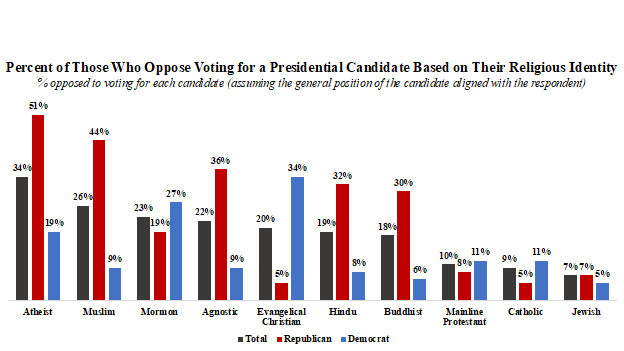
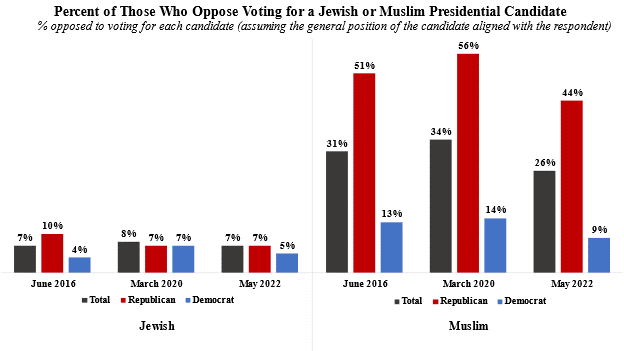
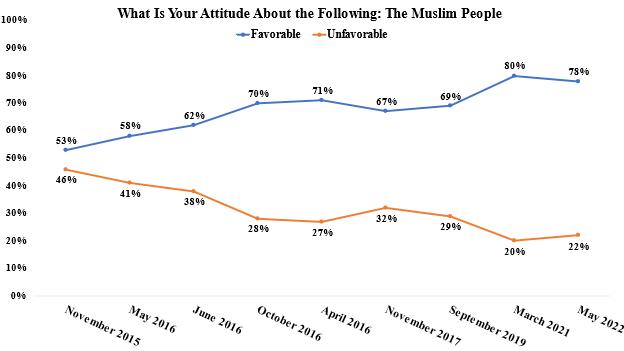
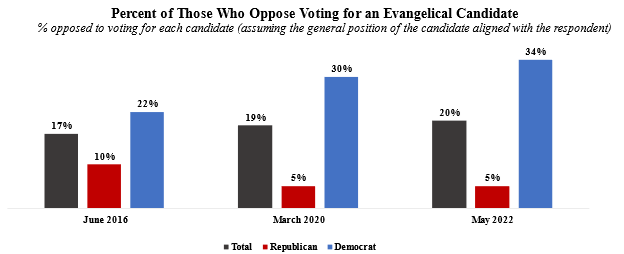
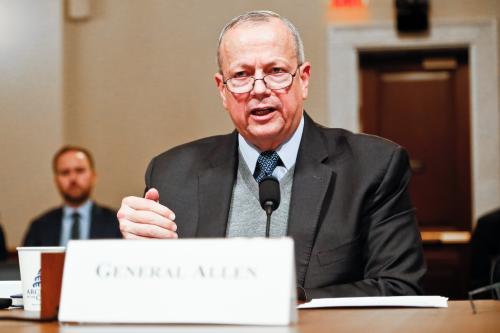
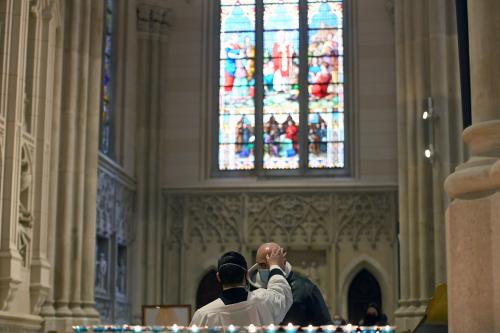






Commentary
The antisemitic and Islamophobic fringe is alarmingly emboldened—but it’s shrinking
December 29, 2022